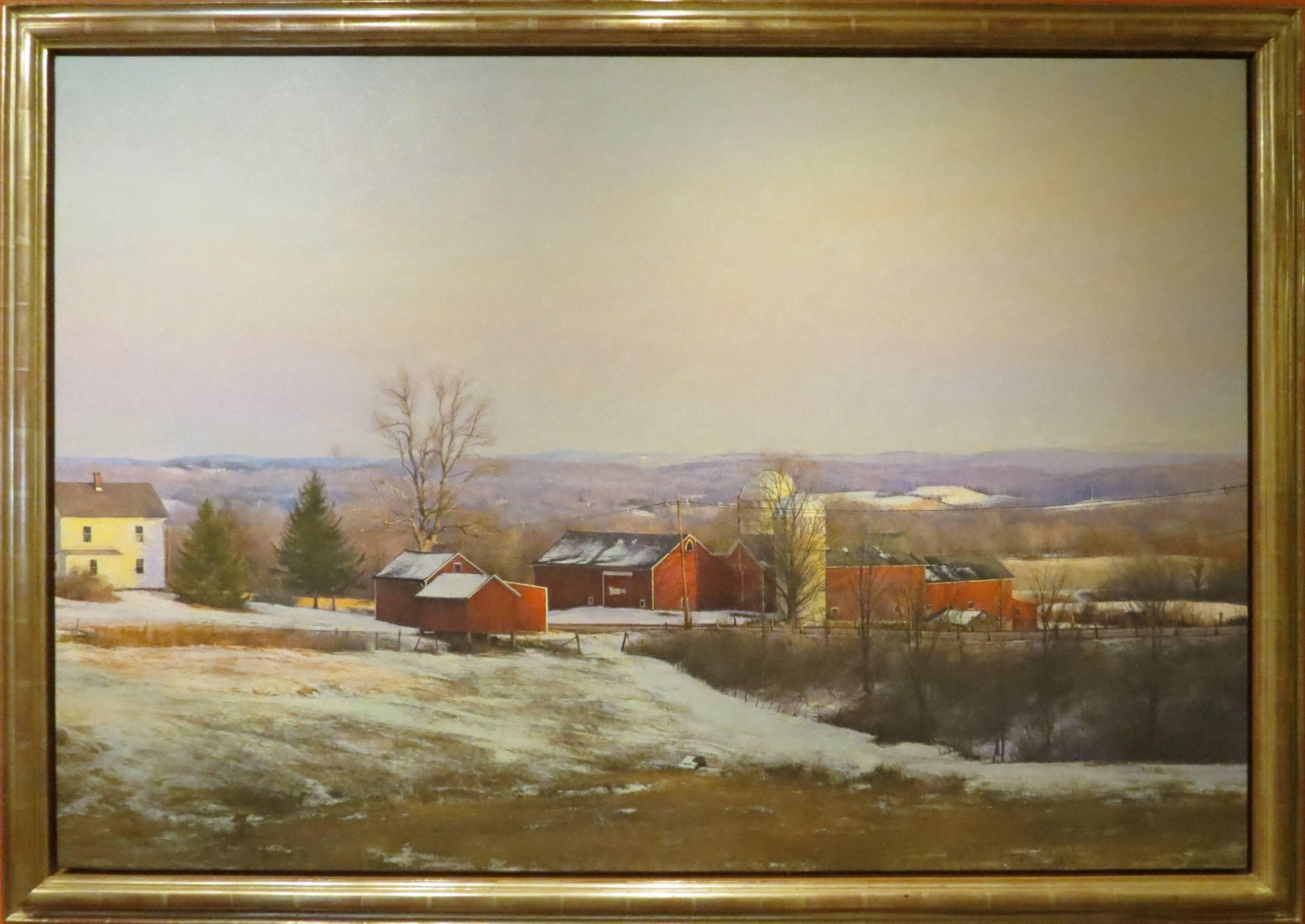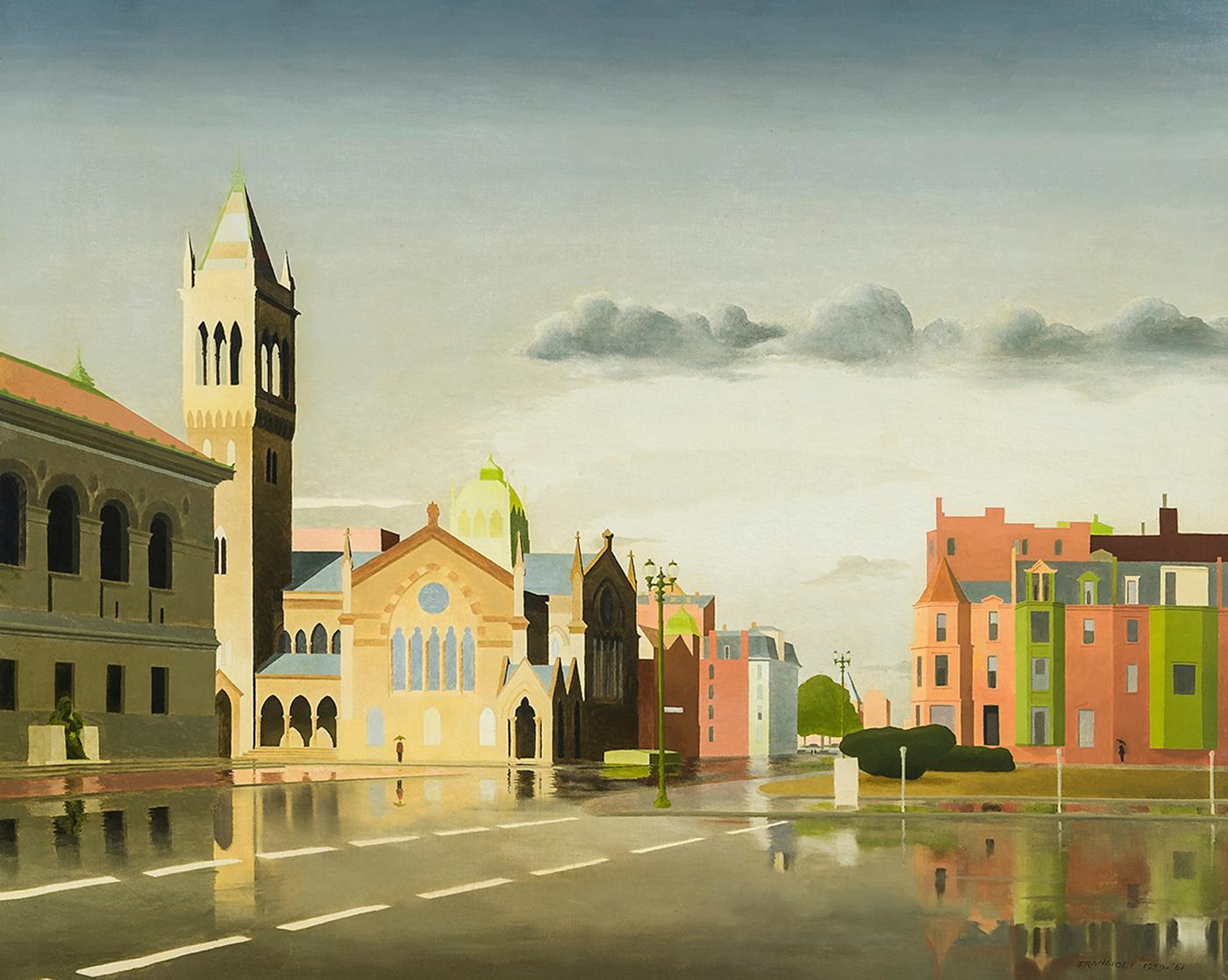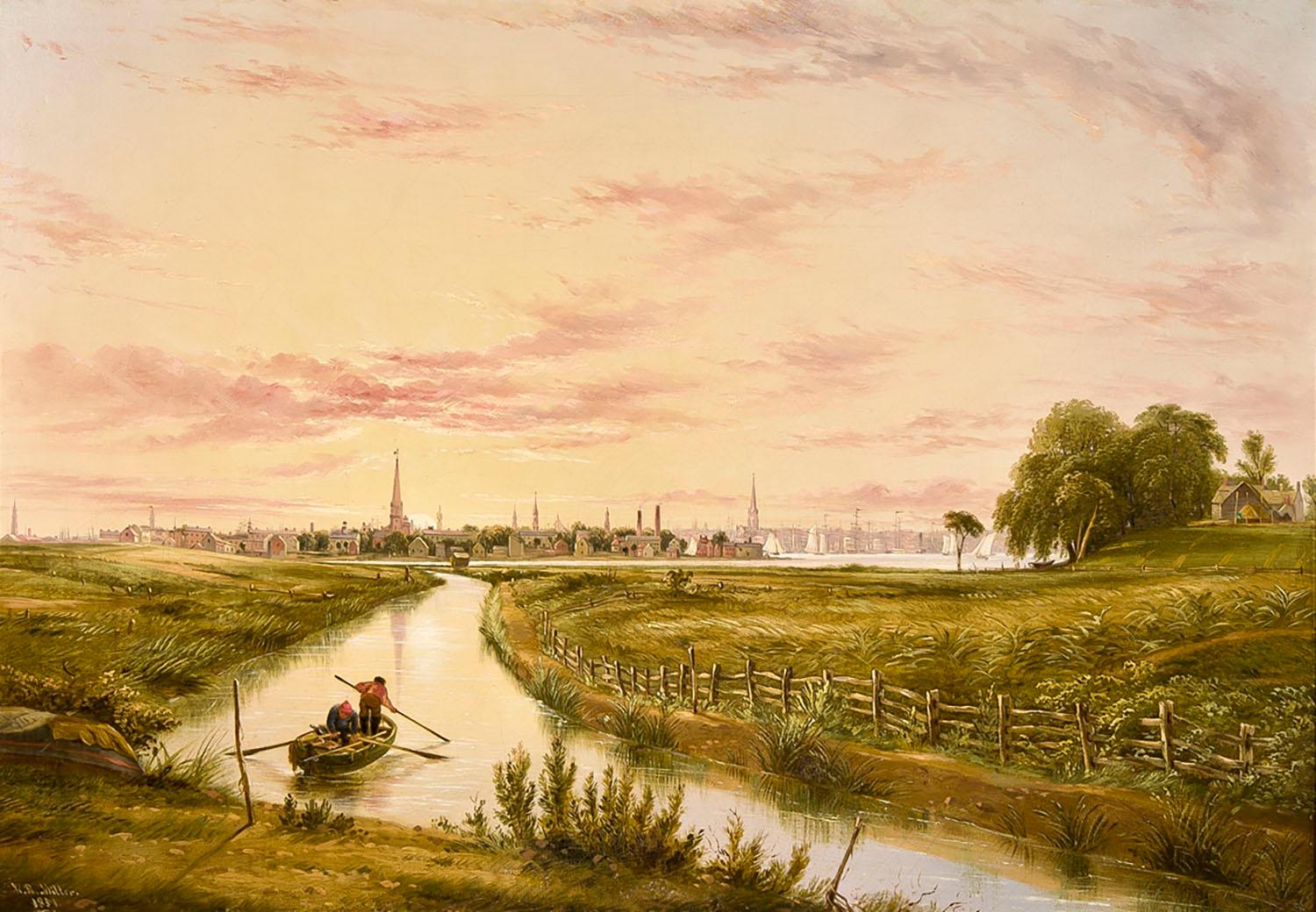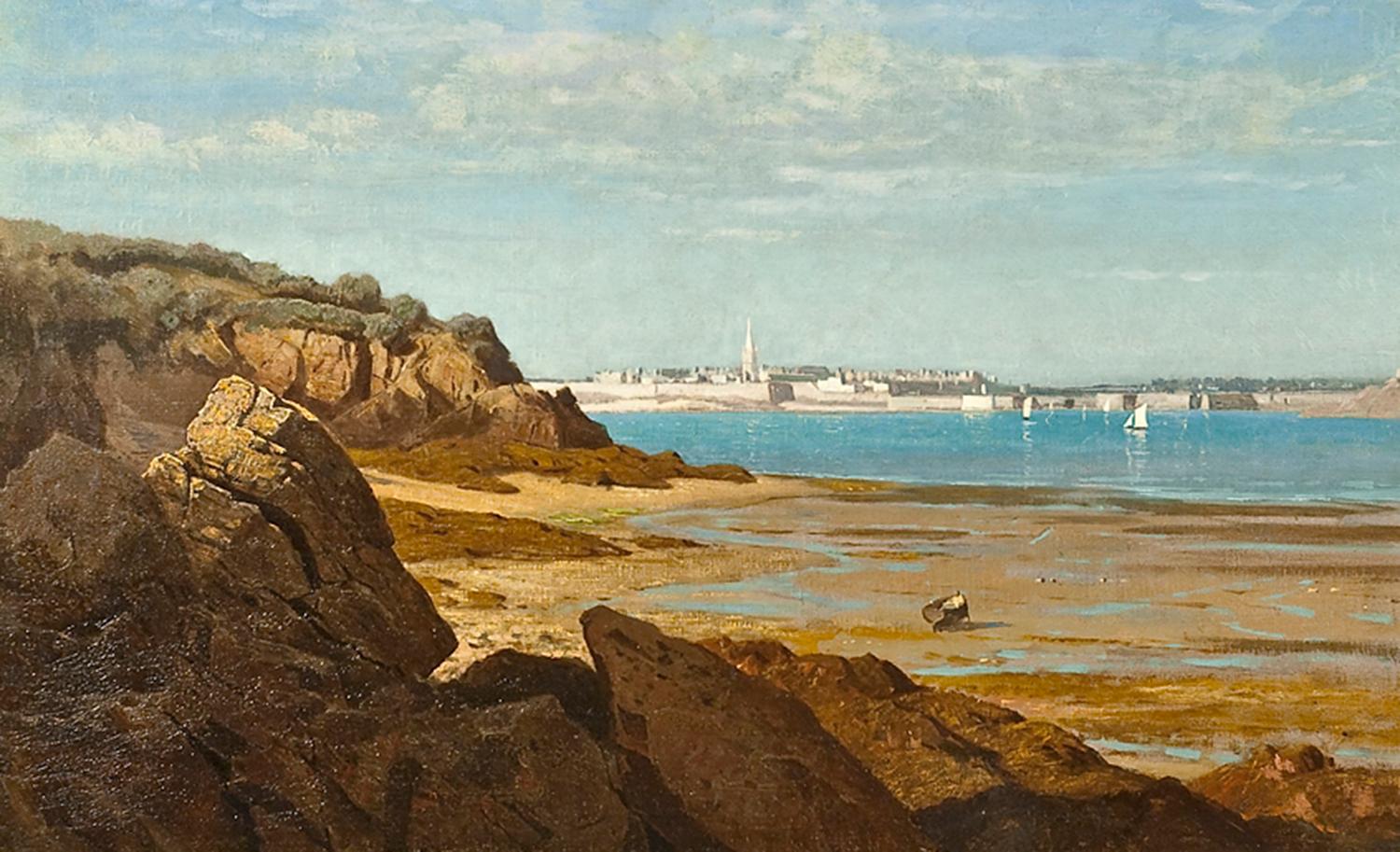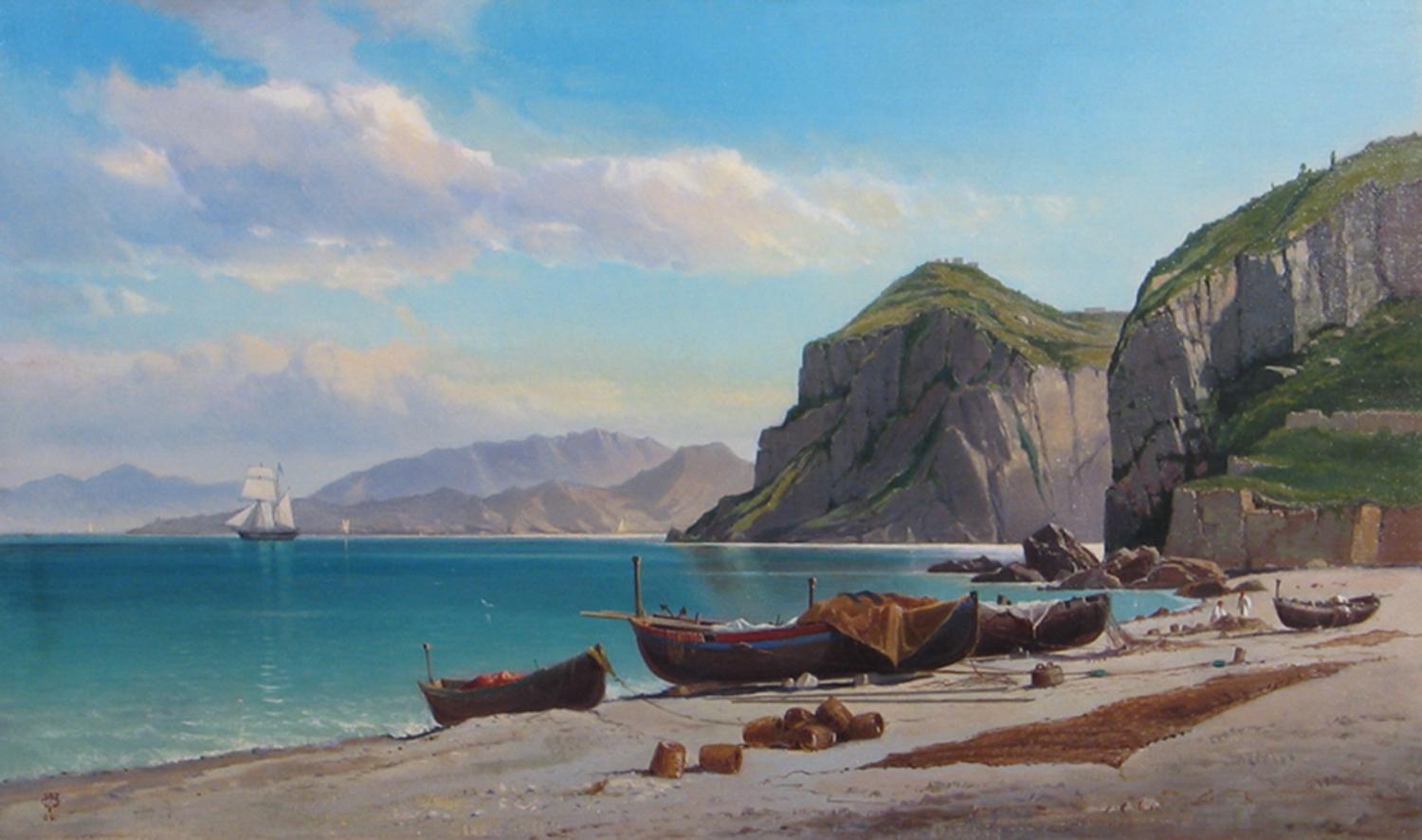Items Similar to The Coming of the Mayflower in 1620
Want more images or videos?
Request additional images or videos from the seller
1 of 10
Newell Convers WyethThe Coming of the Mayflower in 16201941
1941
About the Item
"The Coming of the Mayflower in 1620" is a painting by American artist N.C. Wyeth.
Before there was television and of a time when film was still in its infancy, N. C. Wyeth’s illustrations electrified the stories he visually shaped and annotated. As a young reader of “Treasure Island,” who can deny the urgency to read on to the next glossy illustration? Or, in excited anticipation, thumb through the pages repeatedly to the pictures ahead, so alive and vivid and full of bravado?
In 1939, The Metropolitan Life Company offered Wyeth a commission of a different sort; a series of canvas murals that would rely less on bravado perhaps, but instead, a deep sense of time and place. They would offer an energetic and grand vision and express the spirit of national pride by celebrating the strong values that express what it means to be American. Wyeth was thrilled. The fourteen mural panels he agreed to produce would bring the world of Pilgrims to glowing life and “serve as a graphic and dramatic expression of the spirit of New England” (Douglas Allen, et al., N. C. Wyeth: The Collected Paintings, Illustrations, and Murals, pg. 169). Wyeth, an artist of unparalleled skill and fully invested in the authenticity of the characters that populate his narratives, relished the opportunity to convey the pride he felt toward his ancestral past.
“The romance of early colonization, especially that of the Pilgrims in Massachusetts, had always excited me. My ancestor, Nicholas Wyeth, came from Wales to Massachusetts in 1647. The spirit of early days on the Massachusetts coast was an oft-discussed subject in my home. I was born in Needham, not far from the town of Plymouth, to which I made many pilgrimages during my boyhood, spending thrilling days in and around that historic territory. With this as a background, it was natural that in my mind and heart should fly to Plymouth and to the Pilgrims as a fitting subject for a series of New England paintings. If then, the warmth and appeal of these paintings is apparent to those who study them, it is principally because they are, in some related way, a statement of my own life and heritage.” (Douglas Allen, et al., N. C. Wyeth: The Collected Paintings, Illustrations and Murals, pg. 171)
N.C. Wyeth had achieved preeminence as a mural painter earlier in the 1930s. But the scale and scope of the so-called “New England Series” is a landmark achievement. The story he tells is of shared community, of family, of differing cultures, and courage in the face of great adversity. Installed throughout the common areas of the company’s North Building New York headquarters on Madison Square, the panels were placed at eye level so that they not only served as companions for hundreds of MetLife employees but as invitations to enter the scenes vicariously. The murals remained virtually unseen by the public until 1986 when they were removed, conserved, and exhibited at the Heckscher Museum in Huntington, New York. Still later, in 1991, reproductions of the murals inspired an author to write an accompanying text for N. C. Wyeth’s Pilgrims, a landscape-formatted storybook that utilizes reproductions of the panels to illustrate the bravery of one hundred and two passengers who arrived, and whose ranks were reduced by half their number the first winter, weathered illness, privation, and adversity of every kind to endure and become what is essentially the founding of America.
Wyeth was to devote much of his last years to the Metropolitan Life murals. Yet he was not destined to see its completion when his life ended tragically on a railroad crossing during a morning drive in October 1945. Intent upon seeing his father’s final project finished, son Andrew and son-in-law, John W. McCoy completed the remaining four murals — a fitting memorial to perhaps the greatest American artist of the golden age of illustration.
Provenance:
MetLife, Inc. Corporate Collection (Commissioned for New York offices)
Heather James Fine Art, New York
Exhibition:
New York, NY, 1985, no. 13, "Coming of the Mayflower"
Literature:
"The Days of the Pilgrims Live Again in Our Murals," The Home Office (publication of Metropolitan Life Insurance Co.), vol. 23. no. 7 (Dec. 1941)
N. C. Wyeth, Income Tax Notes for 1941 (unpublished, Brandywine River Museum Library)
Douglas Allen and Douglas Allen, Jr., N. C. Wyeth, The Collected Paintings, Illustrations and Murals (New York: Crown Publishers, 1972), ps. 169-172, illus. b/w p. 169
Robert San Souci, N. C. Wyeth's Pilgrims (San Francisco, CA: Chronicle Books, 1991), detail illus. On frontispiece
Christine B. Podmaniczky, N. C. Wyeth, A Catalogue Raisonné of Paintings (London: Scala, 2008), M.67, p. 629
- Creator:Newell Convers Wyeth (1882-1945, American)
- Creation Year:1941
- Dimensions:Height: 104.5 in (265.43 cm)Width: 158.75 in (403.23 cm)
- Medium:
- Movement & Style:
- Period:
- Condition:
- Gallery Location:Palm Desert, CA
- Reference Number:
About the Seller
4.8
Recognized Seller
These prestigious sellers are industry leaders and represent the highest echelon for item quality and design.
Established in 1996
1stDibs seller since 2011
101 sales on 1stDibs
Typical response time: 6 hours
- ShippingRetrieving quote...Ships From: Jackson, WY
- Return PolicyA return for this item may be initiated within 7 days of delivery.
More From This SellerView All
- ScoutingBy Frank Tenney JohnsonLocated in Palm Desert, CA"Scouting" is an oil on canvas painting by Frank Tenney Johnson. The framed piece measures 23 3/4 x 27 3/4 x 3 1/4 inches. Johnson was well-known for his work of the American west, particularly for his portrayal of cowboys at night, lit by moonlight. Johnson utilized knives and fingers when painting, so his work is recognizable for its distinctive marks. Provenance: Biltmore Galleries, Scottsdale...Category
Early 20th Century American Realist Landscape Paintings
MaterialsCanvas, Oil
- ApachesBy Olaf WieghorstLocated in Palm Desert, CA"Apaches" is an oil on canvas painting by Olaf Wieghorst. The painting is signed on the lower left, "O-Wieghorst". The framed piece measures 25 1/2 x 29 3/4 x 2 in. “When the time comes for me to put away my palette and unsaddle my pony for the last time, I hope that my canvases will in some small measure add to the historical recording of an era, the cowboy, and the great American West.” ~ Olaf Wieghorst Wieghorst worked with the mounted patrol of the 7th Cavalry Regiment of the United States Cavalry (1920-1922) with occasional interludes as a wrangler on ranches in the western states. Wherever he went, he sketched and painted the Western culture he loved, often selling his work as calendar and magazine illustrations. His work appeared in Zane Grey...Category
Early 20th Century American Realist Landscape Paintings
MaterialsOil, Canvas
- Puritan Cod FishersLocated in Palm Desert, CAA painting by father and son N.C. Wyeth and Andrew Wyeth. "Puritan Cod Fishers" is a 20th century painting from N.C. Wyeth's commission of murals for the Metropolitan Life Insurance...Category
20th Century American Realist Figurative Paintings
MaterialsOil, Canvas
- The Young ArtistBy Grant WoodLocated in Palm Desert, CA"The Young Artist" is an oil on panel painting made in 1926 by Grant Wood. The work is signed lower right, "Grant Wood". The painting size is 11 x 14 x 1 inches. The framed size is 2...Category
Early 20th Century American Realist Landscape Paintings
MaterialsOil, Panel
- Navajo CampBy Gerard Curtis DelanoLocated in Palm Desert, CA"Navajo Camp" is an oil on panel painting by Gerard Curtis Delano. The painting is signed lower left "Delano". The framed piece measures 31 x 36 3/4 x 1 7/8 inches. Delano was a pai...Category
Early 20th Century American Realist Landscape Paintings
MaterialsPanel, Oil
- Hoeing CottonBy Thomas Hart BentonLocated in Palm Desert, CA“Hoeing Cotton” is an oil on tin painting by Thomas Hart Benton, painted in 1932. The painting size is 9 1/8 x 13 inches. The framed size is 15 1/4 x 19 x 1 3/4 inches. The work is s...Category
Early 20th Century American Realist Landscape Paintings
MaterialsOil
You May Also Like
- "Snow Squals, Parmelee Farm"By Peter PoskasLocated in Lambertville, NJSigned Lower Left Poskas was born in Waterbury, Connecticut, a small industrial city set on the banks of the Naugatuck River. He was interested in art as a child, but on entering ...Category
20th Century American Realist Landscape Paintings
MaterialsCanvas, Oil
- Strawberries Strewn on a Forest FloorBy William Mason BrownLocated in New York, NYWilliam Mason Brown was born in Troy, New York, where he studied for several years with local artists, including the leading portraitist there, Abel Buel Moore. In 1850, he moved to ...Category
19th Century American Realist Landscape Paintings
MaterialsCanvas, Oil
- Copley Square, BostonBy Thomas FransioliLocated in New York, NYThomas Fransioli’s cityscapes are crisp and tidy. Buildings stand in bold outline, trees are sharp, and saturated color permeates the scene. But Fransioli’s cities often lack one critical feature: people. His streets are largely deserted, save for the rare appearance of figure and the occasional black cat scurrying across pavement. Instead, humanity is implied. Magic Realism neatly characterizes Fransioli’s viewpoint. First applied to American art in the 1943 MoMA exhibition “American Realists and Magic Realists...Category
20th Century American Realist Landscape Paintings
MaterialsCanvas, Oil
- New York from HobokenBy William Rickarby MillerLocated in New York, NYSigned (at lower left): W.R. Miller/ 1851Category
Mid-19th Century American Realist Landscape Paintings
MaterialsCanvas, Oil
- Saint-Malo, BrittanyBy William Stanley HaseltineLocated in New York, NYThe career of William Stanley Haseltine spans the entire second half of the nineteenth century. During these years he witnessed the growth and decline of American landscape painting, the new concept of plein-air painting practiced by the Barbizon artists, and the revolutionary techniques of the French Impressionists, all of which had profound effects on the development of painting in the western world. Haseltine remained open to these new developments, selecting aspects of each and assimilating them into his work. What remained constant was his love of nature and his skill at rendering exactly what he saw. His views, at once precise and poetic, are, in effect, portraits of the many places he visited and the landscapes he loved. Haseltine was born in Philadelphia, the son of a prosperous businessman. In 1850, at the age of fifteen, he began his art studies with Paul Weber, a German artist who had settled in Philadelphia two years earlier. From Weber, Haseltine learned about Romanticism and the meticulous draftsmanship that characterized the German School. At the same time, Haseltine enrolled at the University of Pennsylvania, and took sketching trips around the Pennsylvania countryside, exploring areas along the Delaware and Susquehanna rivers. Following his sophomore year, Haseltine transferred to Harvard University. After graduating from Harvard in 1854, Haseltine returned to Philadelphia and resumed his studies with Weber. Although Weber encouraged Haseltine to continue his training in Europe, the elder Haseltine was reluctant to encourage his son to pursue a career as an artist. During the next year, Haseltine took various sketching trips along the Hudson River and produced a number of pictures, some of which were exhibited at the Pennsylvania Academy of the Fine Arts in the spring of 1855. Ultimately, having convinced his father that he should be allowed to study in Europe, Haseltine accompanied Weber to Düsseldorf. The Düsseldorf Academy was, during the 1850s, at the peak of its popularity among American artists. The Academy’s strict course of study emphasized the importance of accurate draftsmanship and a strong sense of professionalism. Landscape painting was the dominant department at the Düsseldorf Academy during this period, and the most famous landscape painter there was Andreas Achenbach, under whom Haseltine studied. Achenbach’s realistic style stressed close observation of form and detail, and reinforced much of what Haseltine had already learned. His Düsseldorf training remained an important influence on him for the rest of his life. At Düsseldorf, Haseltine became friendly with other American artists studying there, especially Emanuel Leutze, Worthington Whittredge, and Albert Bierstadt. They were constant companions, and in the spring and summer months took sketching trips together. In the summer of 1856 the group took a tour of the Rhine, Ahr, and Nahe valleys, continuing through the Swiss alps and over the Saint Gotthard Pass into northern Italy. The following summer Haseltine, Whittredge, and the painter John Irving returned to Switzerland and Italy, and this time continued on to Rome. Rome was a fertile ground for artists at mid-century. When Haseltine arrived in the fall of 1857, the American sculptors Harriet Hosmer, Chauncey B. Ives, Joseph Mozier, William Henry Rinehart...Category
19th Century American Realist Landscape Paintings
MaterialsCanvas, Oil
- Marina Grande, CapriBy Charles Temple DixLocated in New York, NYCharles Temple Dix was born in Albany, New York, the youngest son of the distinguished statesman and soldier, General John Adams Dix. Having already visited Europe as a child, Dix re...Category
19th Century American Realist Landscape Paintings
MaterialsCanvas, Oil
Recently Viewed
View AllMore Ways To Browse
Utica Club
Bronze Painting Vintage
Countryside Il
Sellers In Colorado
Seascape Gloucester Painting
George Bloom
Swiss Chalet Clock
Tiffany And Co San Francisco Ca
Tiffany Austin Tx
Tiffany Baby Book
V Lindstrom
Vintage Fishing Line Winder
Walter Williams On Sale
William Anslow Thornley On Sale
Young And Hinkle
Young Hinkle
Albert Derome
Albert Insley
